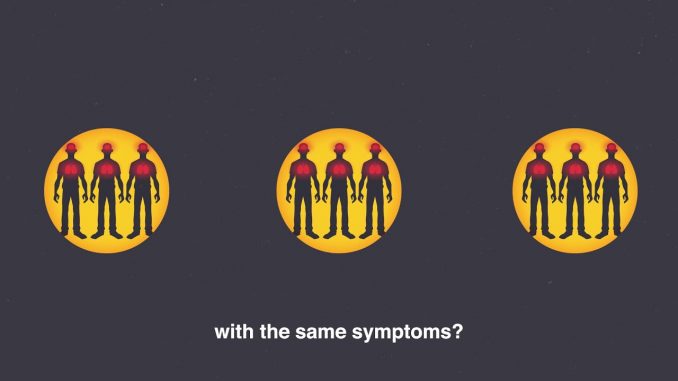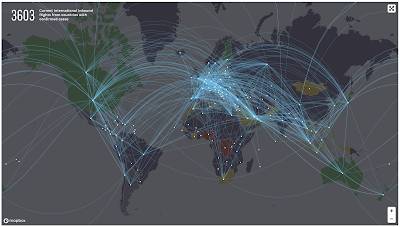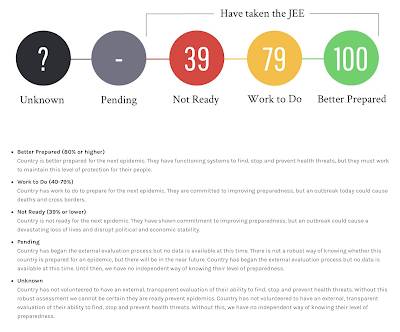
With countries around the globe ramping up their efforts to control the COVID-19 pandemic, an analysis by Prevent Epidemics is very pertinent to any discussion about the spread of the novel coronavirus. In this analysis, Prevent Epidemics provides country-level information on the preparedness of each nation to stop the spread of disease and to prevent the spread of new disease threats including COVID-19.
Let's open with this graphic showing the current international inbound flights from nations with confirmed cases of COVID-19 (noting that the graphic simply shows one landing point for each nation):
This graphic gives us a sense of how viruses can spread very quickly around the world.
Now, let's look at the ReadyScore tool which was created to show how prepared a nation is to find, stop and prevent epidemics. According to Prevent Epidemics, the ReadyScore is calculated…
…"using data from the World Health Organization’s Joint External Evaluation (JEE) tool which is both voluntary and transparent. The JEE report is similar to a report card, there are 19 areas of preparedness and response capacity that are scored, and the ReadyScore is the average score of those 19 scores."
Here is a video from Resolve to Save Lives showing how important pandemic preparedness is and how the JEE works:
The JEE is conducted as follows:
"The Joint External Evaluation (JEE) is a comprehensive, standardized and transparent assessment of a country’s ability to find, stop and prevent disease threats, conducted first by a group of domestic experts and then validated by an external group of independent international experts. Like a report card, 19 areas of epidemic preparedness and response capacity are assessed and then scored. The assessment is voluntary, initiated by a country, conducted approximately every five years, and the results are published by the World Health Organization (WHO), partners and the countries themselves. The WHO also uses other processes, including mandated annual self-reporting (the results of which are also presented on this site), simulated exercises, and after-action reports to help countries assess and identify areas for improvement of preparedness."
Here's how the JEE is used to calculate the ReadyScore:
"The 19 areas of epidemic preparedness are grouped into categories of preventing, detecting and responding to health threats. Within those areas more than 50 factors are assessed, such as whether a country has a national laboratory system to diagnose diseases, or what is the capacity of its public health workforce to find, stop and prevent epidemics. The Joint External Evaluation (JEE) rates each of the indicators on a scale of 1 – 5. One, is “no capacity” and is coded red. Two and three indicate the “need to build capacity” and are coded yellow. Four and five indicate “sustainable capacity” and are in the desired green band. The ReadyScore is the average score of the 19-areas scores, placed on a scale of 0 to 100."
Here is a graphic breaking down the ReadyScore into five levels of preparedness:
Let's look at the countries that are better prepared for preventing epidemics in order from the highest score to lowest score noting that a significant number of nations have no score at this time:
Canada – 93
Singapore – 93
Australia – 92
Japan – 92
Republic of Korea – 92
United Arab Emirates – 92
Armenia – 90
New Zealand – 89
Switzerland – 89
United States of America – 87
Finland – 86
Belgium – 85
Oman – 84
Slovenia – 82
Bahrain – 80
It is interesting to note that, while the United States is considered to be well prepared for preventing an epidemic, its score is lower than its most direct peer, Canada, which has a strong tradition of socialized health care.
Now, let's look at the least prepared nations noting that a significant number of nations have no score as noted above:
Nigeria – 39
Afghanistan – 38
Cameroon – 38
Togo – 36
Democratic Republic of the Congo – 35
Burkina Faso – 34
Here are the scores of some other key nations:
Saudi Arabia – 76
Thailand – 76
Kuwait – 74
Indonesia – 64
South Africa – 62
Jordan – 57
Sri Lanka – 57
Viet Nam – 57
Philippines – 52
Bangladesh – 50
Pakistan – 50
Cambodia – 48
Iraq – 46
As you can see, the global level of preparedness for dealing with or preventing a pandemic varies widely with some nations, particularly those that are classified as developing economies, being extremely poorly prepared while others, mainly those classified as advanced economies, being relatively well prepared. Unfortunately, those nations that are poorly prepared do not have the financial means to improve their level of preparedness and will continue to be at high risk for both the current pandemic and future pandemics as well as increasing the global vulnerability to disease.
Click HERE to read more from this author.
You can publish this article on your website as long as you provide a link back to this page.



Be the first to comment